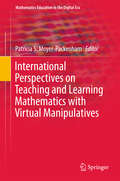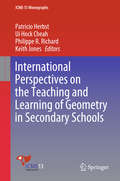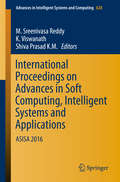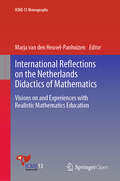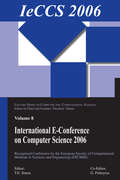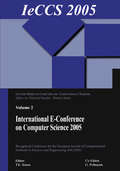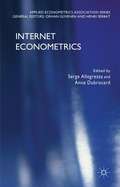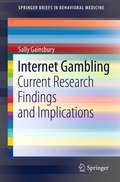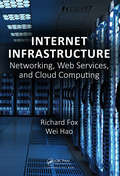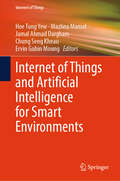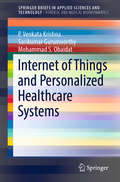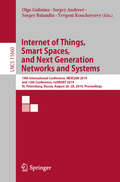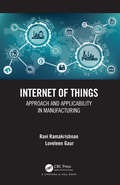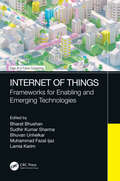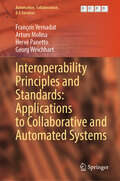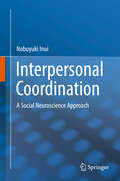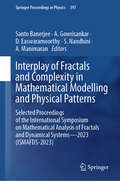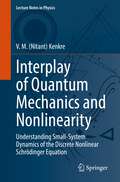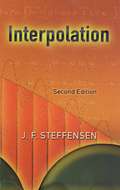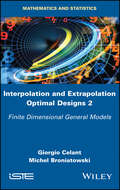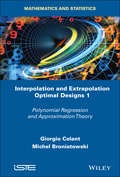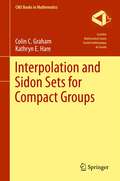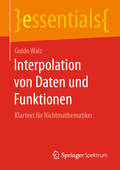- Table View
- List View
International Perspectives on Teaching and Learning Mathematics with Virtual Manipulatives
by Patricia S. Moyer-PackenhamThis book explores terminology, frameworks, and research being conducted worldwide on virtual manipulatives. It brings together international authors who provide their perspectives on virtual manipulatives in research and teaching. By defining terminology, explaining conceptual and theoretical frameworks, and reporting research, the authors provide a comprehensive foundation on the study and use of virtual manipulatives for mathematics teaching and learning. This foundation provides a common way for researchers to communicate about virtual manipulatives and build on the major works that have been conducted on this topic. By discussing these big ideas, the book advances knowledge for future research on virtual manipulatives as these dynamic tools move from computer platforms to hand-held, touch-screen, and augmented platforms.
International Perspectives on the Teaching and Learning of Geometry in Secondary Schools (ICME-13 Monographs)
by Keith Jones Patricio Herbst Ui Hock Cheah Philippe R. RichardThis book presents current perspectives on theoretical and empirical issues related to the teaching and learning of geometry at secondary schools. It contains chapters contributing to three main areas. A first set of chapters examines mathematical, epistemological, and curricular perspectives. A second set of chapters presents studies on geometry instruction and teacher knowledge, and a third set of chapters offers studies on geometry thinking and learning. Specific research topics addressed also include teaching practice, learning trajectories, learning difficulties, technological resources, instructional design, assessments, textbook analyses, and teacher education in geometry. Geometry remains an essential and critical topic in school mathematics. As they learn geometry, students develop essential mathematical thinking and visualization skills and learn a language that helps them relate to and interact with the physical world. Geometry has traditionally been included as a subject of study in secondary mathematics curricula, but it has also featured as a resource in out-of-school problem solving, and has been connected to various human activities such as sports, games, and artwork. Furthermore, geometry often plays a role in teacher preparation, undergraduate mathematics, and at the workplace. New technologies, including dynamic geometry software, computer-assisted design software, and geometric positioning systems, have provided more resources for teachers to design environments and tasks in which students can learn and use geometry. In this context, research on the teaching and learning of geometry will continue to be a key element on the research agendas of mathematics educators, as researchers continue to look for ways to enhance student learning and to understand student thinking and teachers’ decision making.
International Proceedings on Advances in Soft Computing, Intelligent Systems and Applications
by K. Viswanath M. Sreenivasa Reddy Shiva Prasad K.M.The book focuses on the state-of-the-art technologies pertaining to advances in soft computing, intelligent system and applications. The Proceedings of ASISA 2016 presents novel and original work in soft computing, intelligent system and applications by the experts and budding researchers. These are the cutting edge technologies that have immense application in various fields. The papers discuss many real world complex problems that cannot be easily handled with traditional mathematical methods. The exact solution of the problems at hand can be achieved with soft computing techniques. Soft computing represents a collection of computational techniques inheriting inspiration from evolutionary algorithms, nature inspired algorithms, bio-inspired algorithms, neural networks and fuzzy logic.
International Reflections on the Netherlands Didactics of Mathematics: Visions on and Experiences with Realistic Mathematics Education (ICME-13 Monographs)
by Marja van den Heuvel-PanhuizenThis open access book, inspired by the ICME 13 Thematic Afternoon on “European Didactic Traditions”, takes readers on a journey with mathematics education researchers, developers and educators in eighteen countries, who reflect on their experiences with Realistic Mathematics Education (RME), the domain-specific instruction theory for mathematics education developed in the Netherlands since the late 1960s. Authors from outside the Netherlands discuss what aspects of RME appeal to them, their criticisms of RME and their past and current RME-based projects. It is clear that a particular approach to mathematics education cannot simply be transplanted to another country. As such, in eighteen chapters the authors describe how they have adapted RME to their individual circumstances and view on mathematics education, and tell their personal stories about how RME has influenced their thinking on mathematics education.
International Relations Theory: The Game-Theoretic Approach
by Andrew H. KyddWritten for advanced undergraduate and graduate students, this is the first textbook on international relations theory to take a specifically game-theoretic approach to the subject, and provide the material needed for students to understand the subject thoroughly, from its basic foundations to more complex models. International relations theory is presented and analysed using simple games, which allow students to grasp the concepts and mechanisms involved with the rationalist approach without the distraction of complicated mathematics. Chapter exercises reinforce key concepts and guide students to extend the models discussed. Drawing examples from international security, international political economy, and environmental negotiations, this introductory textbook examines a broad array of topics in international relations courses, including state preferences, normal form games, bargaining, uncertainty and communication, multilateral cooperation, and the impact of domestic politics.
International e-Conference of Computer Science 2006: Additional Papers from ICNAAM 2006 and ICCMSE 2006
by Theodore Simos Georgios PsihoyiosLecture Series on Computer and on Computational Sciences (LSCCS) aims to provide a medium for the publication of new results and developments of high-level research and education in the field of computer and computational science.In this series, only selected proceedings of conferences in all areas of computer science and computational sciences wil
International e-Conference on Computer Science (IeCCS 2005)
by Theodore SimosThe aim of IeCCS 2005, which was held in May 2005, was to bring together leading scientists of the international Computer Science community and to attract original research papers. This volume in the Lecture Series on Computer and Computational Sciences contains the extended abstracts of the presentations. The topics covered included (but were not limited to): Numerical Analysis, Scientific Computation, Computational Mathematics, Mathematical Software, Programming Techniques and Languages, Parallel Algorithms and its Applications, Symbolic and Algebraic Manipulation, Analysis of Algorithms, Problem Complexity, Mathematical Logic, Formal Languages, Data Structures, Data Bases, Information Systems, Artificial Intelligence, Expert Systems, Simulation and Modeling, Computer Graphics, Software Engineering, Image Processing, Computer Applications, Hardware, Computer Systems Organization, Software, Data, Theory of Computation, Mathematics of Computing, Information Systems, Computing Methodologies, Computer Applications and Computing Milieu.
Internet Econometrics
by Serge Allegrezza Anne DubrocardThe proliferation of the internet has often been referred to as the fourth technological revolution. This book explores the diffusion of radical new communication technologies, and the subsequent transformation not only of products, but also of the organisation of production and business methods.
Internet Gambling
by Sally GainsburyInternet gambling is one of the fastest growing forms of gambling. Global Internet gambling expenditure is predicted to reach US$33.6 billion in 2011. This is higher than worldwide movie box office revenues and represents 9% of the international gambling market. The rapid increase in expenditure of 354% since 2003 has occurred despite Internet gambling being prohibited in several key markets, including the US and China. It also suggests that current regulation may be somewhat outdated and ineffective as more and more people turn to this mode of gambling. Internet gambling is highly accessible with over 2,400 sites available 24/7 through computers, mobile phones, wireless devices and even interactive televisions. Gamblers can now play casino games, bingo, cards and poker, bet on races, sports and even celebrity weddings using over 199 means of electronic payments without leaving the house. Increasing international jurisdictions are legalizing Internet gambling and the constant accessibility of online gambling has critical social implications. Gambling operators are using aggressive advertising campaigns to move into new markets. Internet gambling appears to be particularly appealing to youth, who are gambling online at substantially higher rates than adults. Furthermore, Internet gambling appears to be related to problem gambling, with rates of problem gambling three to four times higher among Internet than non-Internet gamblers, indicating that it may have a substantial social cost. The anonymity of online sports betting poses a significant threat to the integrity of sport at all levels with increasing allegations of match-fixing and cheating. Estimates suggested that 50% of all bets on the 2010 FIFA World Cup were placed online, worth an estimated £500 million. These figures represent a 700% rise in online betting since the 2006 tournament and included many new players that opened online accounts. It is essential that appropriate responses are made by governments, industry professionals and the public in response to Internet gambling. This book will provide a comprehensive and up-to-date overview of Internet gambling, including the social impact and regulatory options. A global outline will include the characteristics and features of the many forms of Internet gambling, including the current market, and participation, and differences between Internet and non-Internet gambling. Specific regional considerations will be explored including regulatory responses and options. Importantly, the social consequences and costs of Internet gambling will be examined, including the impact of online gambling on sports, youth and problem gambling. Strategies for prevention and responsible gambling will be considered as well as expected trends.
Internet Infrastructure: Networking, Web Services, and Cloud Computing
by Richard Fox Wei HaoInternet Infrastructure: Networking, Web Services, and Cloud Computing provides a comprehensive introduction to networks and the Internet from several perspectives: the underlying media, the protocols, the hardware, the servers, and their uses. The material in the text is divided into concept chapters that are followed up with case study chapters that examine how to install, configure, and secure a server that offers the given service discussed. The book covers in detail the Bind DNS name server, the Apache web server, and the Squid proxy server. It also provides background on those servers by discussing DNS, DHCP, HTTP, HTTPS, digital certificates and encryption, web caches, and the variety of protocols that support web caching. Introductory networking content, as well as advanced Internet content, is also included in chapters on networks, LANs and WANs, TCP/IP, TCP/IP tools, cloud computing, and an examination of the Amazon Cloud Service. Online resources include supplementary content that is available via the textbook’s companion website, as well useful resources for faculty and students alike, including: a complete lab manual; power point notes, for installing, configuring, securing and experimenting with many of the servers discussed in the text; power point notes; animation tutorials to illustrate some of the concepts; two appendices; and complete input/output listings for the example Amazon cloud operations covered in the book.
Internet of Things and Artificial Intelligence for Smart Environments (Internet of Things)
by Hoe Tung Yew Mazlina Mamat Jamal Ahmad Dargham Chung Seng Kheau Ervin Gubin MoungThis book highlights the application of smart technologies that utilize the Internet of Things (IoT) and Artificial Intelligence (AI) to enhance efficiency and productivity across various industries. It provides a comprehensive review of the latest IoT and AI developments, including their applications, opportunities, and challenges in smart environments. This book is a valuable resource for researchers, engineers, academics, and students working on implementing smart technologies.
Internet of Things and Personalized Healthcare Systems (SpringerBriefs in Applied Sciences and Technology)
by Mohammad S. Obaidat Sasikumar Gurumoorthy P. Venkata KrishnaThis book highlights the issues and challenges in personalised healthcare systems. The individual chapters address different aspects of such systems, including the novel Internet of Things (IoT) system architectures in healthcare and emerging e-health based IoT applications. Moreover, the book investigates the impact of cutting-edge innovations on the IoT.
Internet of Things and Secure Smart Environments: Successes and Pitfalls (Chapman & Hall/CRC Big Data Series)
by Uttam Ghosh, Danda B Rawat, Raja Datta and Al-Sakib Khan PathanThe main goal of Internet of Things (IoT) is to make secure, reliable, and fully automated smart environments. However, there are many technological challenges in deploying IoT. This includes connectivity and networking, timeliness, power and energy consumption dependability, security and privacy, compatibility and longevity, and network/protocol standards. Internet of Things and Secure Smart Environments: Successes and Pitfalls provides a comprehensive overview of recent research and open problems in the area of IoT research. Features: Presents cutting edge topics and research in IoT Includes contributions from leading worldwide researchers Focuses on IoT architectures for smart environments Explores security, privacy, and trust Covers data handling and management (accumulation, abstraction, storage, processing, encryption, fast retrieval, security, and privacy) in IoT for smart environments This book covers state-of-the-art problems, presents solutions, and opens research directions for researchers and scholars in both industry and academia.
Internet of Things, Smart Spaces, and Next Generation Networks and Systems: 19th International Conference, NEW2AN 2019, and 12th Conference, ruSMART 2019, St. Petersburg, Russia, August 26–28, 2019, Proceedings (Lecture Notes in Computer Science #11660)
by Yevgeni Koucheryavy Olga Galinina Sergey Balandin Sergey AndreevThis book constitutes the joint refereed proceedings of the 19th International Conference on Next Generation Teletraffic and Wired/Wireless Advanced Networks and Systems, NEW2AN 2019, and the 12th Conference on Internet of Things and Smart Spaces, ruSMART 2019.The 66 revised full papers presented were carefully reviewed and selected from 192 submissions. The papers of NEW2AN address various aspects of next-generation data networks, with special attention to advanced wireless networking and applications. In particular, they deal with novel and innovative approaches to performance and efficiency analysis of 5G and beyond systems, employed game-theoretical formulations, advanced queuing theory, and stochastic geometry, while also covering the Internet of Things, cyber security, optics, signal processing, as well as business aspects.ruSMART 2019, provides a forum for academic and industrial researchers to discuss new ideas and trends in the emerging areas. The 12th conference on the Internet of Things and Smart Spaces, ruSMART 2019, provides a forum for academic and industrial researchers to discuss new ideas and trends in the emerging areas.
Internet of Things: Approach and Applicability in Manufacturing
by Ravi Ramakrishnan Loveleen GaurThe concept of Internet of Things has silently existed since the late nineteenth century but in the current decade expectations and excitement has peaked. However not many have understood the profound change that it can usher in. How big this change can be and how it can transform our working!! This book aims to bring in this realization with illustrative and practical case studies with comprehensive concepts. From beginners to practitioners in the field of academics or industry, it serves as a comprehensive yet easy to comprehend source of information on the multiple facets of IoT. Simplistic but comprehensive introduction of the facets of primarily the industrial IoT Practical adoption cases explaining the Core technology stack and business applications Comprehensive view of current technologies which complete the IoT delivery ecosystem, followed by overview of IoT enabled new business models. Realistic view of how industrial firms can evolve into the next stage of maturity along with determinants influencing this transformation since manufacturing is envisioned to be a key segment to adopt and benefit from IoT. Detailed analysis of IoT benefits for the universal triad- energy management, logistics optimization and distribution channel management. A full-fledged case study on Adoption of Green manufacturing using IoT. Real world example of gauging End User perception using different models which is important for a successful adoption of IoT. A futuristic visionary view of IoT as comprehended based on evolution of technology and platforms, and finally analysis of the extremely crucial concepts of security, privacy and governance.
Internet of Things: Frameworks for Enabling and Emerging Technologies (Edge AI in Future Computing)
by Bharat BhushanToday, Internet of Things (IoT) is ubiquitous as it is applied in practice in everything from Industrial Control Systems (ICS) to e-Health, e-commerce, Cyber Physical Systems (CPS), smart cities, smart parking, healthcare, supply chain management and many more. Numerous industries, academics, alliances and standardization organizations make an effort on IoT standardization, innovation and development. But there is still a need for a comprehensive framework with integrated standards under one IoT vision. Furthermore, the existing IoT systems are vulnerable to huge range of malicious attacks owing to the massive numbers of deployed IoT systems, inadequate data security standards and the resource-constrained nature. Existing security solutions are insufficient and therefore it is necessary to enable the IoT devices to dynamically counter the threats and save the system. Apart from illustrating the diversified IoT applications, this book also addresses the issue of data safekeeping along with the development of new security-enhancing schemes such as blockchain, as well as a range of other advances in IoT. The reader will discover that the IoT facilitates a multidisciplinary approach dedicated to create novel applications and develop integrated solutions to build a sustainable society. The innovative and fresh advances that demonstrate IoT and computational intelligence in practice are discussed in this book, which will be helpful and informative for scientists, research scholars, academicians, policymakers, industry professionals, government organizations and others. This book is intended for a broad target audience, including scholars of various generations and disciplines, recognized scholars (lecturers and professors) and young researchers (postgraduate and undergraduates) who study the legal and socio-economic consequences of the emergence and dissemination of digital technologies such as IoT. Furthermore, the book is intended for researchers, developers and operators working in the field of IoT and eager to comprehend the vulnerability of the IoT paradigm. The book will serve as a comprehensive guide for the advanced-level students in computer science who are interested in understanding the severity and implications of the accompanied security issues in IoT. Dr. Bharat Bhushan is an Assistant Professor of Department of Computer Science and Engineering (CSE) at School of Engineering and Technology, Sharda University, Greater Noida, India. Prof. (Dr.) Sudhir Kumar Sharma is currently a Professor and Head of the Department of Computer Science, Institute of Information Technology & Management affiliated to GGSIPU, New Delhi, India. Prof. (Dr.) Bhuvan Unhelkar (BE, MDBA, MSc, PhD; FACS; PSM-I, CBAP®) is an accomplished IT professional and Professor of IT at the University of South Florida, Sarasota-Manatee (Lead Faculty). Dr. Muhammad Fazal Ijaz is working as an Assistant Professor in Department of Intelligent Mechatronics Engineering, Sejong University, Seoul, Korea. Prof. (Dr.) Lamia Karim is a professor of computer science at the National School of Applied Sciences Berrechid (ENSAB), Hassan 1st University.
Interoperability Principles and Standards: Applications to Collaborative and Automated Systems (Automation, Collaboration, & E-Services #16)
by Arturo Molina Hervé Panetto Georg Weichhart François VernadatInteroperability is the ability for two or more systems to interoperate, i.e., to share and use common information and/or to use functionality of one another. The purpose of the book is to explain what one should know to be able to understand or implement systems interoperability at the technical, semantic and organization levels of an enterprise system or of a collaborative automated system. In particular, it presents the rationale, the basics, the common methods and the essential standards for the engineering of interoperable systems. The book is intended to serve as a textbook for those who need (1) to study basic principles, concepts and techniques along with applications of systems interoperability and (2) need to know applicable standards for planning, engineering or implementing interoperability solutions. Applications will concern, but are not limited to, automated (collaborative) environments. The book should also serve as a reference document for students and academia at under-graduate and graduate levels or in engineering schools as well as for researchers, practitioners, consultants and engineers faced with interoperability problems in service, industrial, government or administrative sectors.
Interpersonal Coordination: A Social Neuroscience Approach
by Nobuyuki InuiThis book explores the fascinating area of interpersonal coordination in force production tasks, outlining the author’s extensive research to date and presenting stimulating new perspectives. The purpose is to provide a detailed exposition of current understanding of the science behind interpersonal joint action. Readers will find clear explanation of concepts from social cognition and neuroscience that are key to an understanding of the field, including the social brain hypothesis, the mirror neuron system, and joint action, as well as other relevant background information. The author then proceeds to present an overview of recent original studies on interpersonal movement coordination performed at his laboratory in Japan. These studies provide insights into such issues as complementary and synchronous force production in joint action, bidirectional transfer between joint and solo actions, and motor control hierarchy in joint action involving bimanual force. They also set the direction for integration of knowledge of physical properties and social cognition. The book will be of interest for researchers and graduate students in all areas of the biomedical sciences.
Interplay of Fractals and Complexity in Mathematical Modelling and Physical Patterns: Selected Proceedings of the International Symposium on Mathematical Analysis of Fractals and Dynamical Systems—2023 (ISMAFDS-2023)
by Santo Banerjee A. Manimaran D. Easwaramoorthy A. Gowrisankar S. NandhiniThis book presents selected, peer-reviewed contributions from the International Symposium on Mathematical Analysis of Fractals and Dynamical Systems—2023 (ISMAFDS - 2023), held at the Department of Mathematics, School of Advanced Sciences, Vellore Institute of Technology, Tamil Nadu in India during August 24-25, 2023. It offers readers an array of captivating connections between fractal theory and nonlinear dynamics across various physics sub-domains and mathematical modeling. Fractal geometry has been developed to describe irregular natural objects that defy characterization using Euclidean geometry. Fractal techniques, such as fractal dimension and fractal functions, prove effective in mathematically modeling real-world phenomena and forecasting future consequences. The impact of fractal theory on physical sciences is widely recognized, as natural phenomena frequently exhibit fractal structures. These new concepts revolutionize our understanding of the large-scale properties of matter distribution in the universe. The book aims to familiarize readers with recent developments in common fractal patterns found in statistical physics, quantum physics, and plasma physics. Furthermore, it highlights the relationship between fractals and nonlinear dynamics through innovative approaches in mathematical modeling. This publication caters to professionals in mathematics, physics, and computer science, and also serves as a helpful resource for non-specialists seeking to comprehend fractal and nonlinear dynamics concepts. It offers valuable applications for researchers in both pure and applied backgrounds of physics and engineering.
Interplay of Quantum Mechanics and Nonlinearity: Understanding Small-System Dynamics of the Discrete Nonlinear Schrödinger Equation (Lecture Notes in Physics #997)
by V. M. KenkreThis book presents an in-depth study of the discrete nonlinear Schrödinger equation (DNLSE), with particular emphasis on spatially small systems that permit analytic solutions. In many quantum systems of contemporary interest, the DNLSE arises as a result of approximate descriptions despite the fundamental linearity of quantum mechanics. Such scenarios, exemplified by polaron physics and Bose-Einstein condensation, provide application areas for the theoretical tools developed in this text. The book begins with an introduction of the DNLSE illustrated with the dimer, development of fundamental analytic tools such as elliptic functions, and the resulting insights into experiment that they allow. Subsequently, the interplay of the initial quantum phase with nonlinearity is studied, leading to novel phenomena with observable implications in fields such as fluorescence depolarization of stick dimers, followed by analysis of more complex and/or larger systems. Specific examples analyzed in the book include the nondegenerate nonlinear dimer, nonlinear trapping, rotational polarons, and the nonadiabatic nonlinear dimer. Phenomena treated include strong carrier-phonon interactions and Bose-Einstein condensation. This book is aimed at researchers and advanced graduate students, with chapter summaries and problems to test the reader’s understanding, along with an extensive bibliography. The book will be essential reading for researchers in condensed matter and low-temperature atomic physics, as well as any scientist who wants fascinating insights into the role of nonlinearity in quantum physics.
Interpolation (Dover Books on Mathematics)
by J. F. SteffensenIn the mathematical subfield of numerical analysis, interpolation is a procedure that assists in "reading between the lines" in a set of tables by constructing new data points from existing points. This rigorous presentation employs only formulas for which it is possible to calculate error limits. Subjects include displacement symbols and differences, divided differences, formulas of interpolation, factorial coefficients, numerical differentiation, and construction of tables. Additional topics include inverse interpolation, elementary methods of summation, repeated summation, mechanical quadrature, numerical integration of differential equations, the calculus of symbols, interpolation with several variables, and mechanical cubature. 1950 edition.
Interpolation and Extrapolation Optimal Designs 2: Finite Dimensional General Models
by Giorgio Celant Michel BroniatowskiThis book considers various extensions of the topics treated in the first volume of this series, in relation to the class of models and the type of criterion for optimality. The regressors are supposed to belong to a generic finite dimensional Haar linear space, which substitutes for the classical polynomial case. The estimation pertains to a general linear form of the coefficients of the model, extending the interpolation and extrapolation framework; the errors in the model may be correlated, and the model may be heteroscedastic. Non-linear models, as well as multivariate ones, are briefly discussed. The book focuses to a large extent on criteria for optimality, and an entire chapter presents algorithms leading to optimal designs in multivariate models. Elfving’s theory and the theorem of equivalence are presented extensively. The volume presents an account of the theory of the approximation of real valued functions, which makes it self-consistent.
Interpolation and Extrapolation Optimal Designs V1: Polynomial Regression and Approximation Theory
by Giorgio Celant Michel BroniatowskiThis book is the first of a series which focuses on the interpolation and extrapolation of optimal designs, an area with significant applications in engineering, physics, chemistry and most experimental fields. In this volume, the authors emphasize the importance of problems associated with the construction of design. After a brief introduction on how the theory of optimal designs meets the theory of the uniform approximation of functions, the authors introduce the basic elements to design planning and link the statistical theory of optimal design and the theory of the uniform approximation of functions. The appendices provide the reader with material to accompany the proofs discussed throughout the book.
Interpolation and Sidon Sets for Compact Groups
by Kathryn E. Hare Colin GrahamUnderstanding special sets of integers was classically of interest to Hadamard, Zygmund and others, and continues to be of interest today. This book is a modern treatment of the subject of interpolation and Sidon sets. It is a unique book, aimed at both new and experienced researchers. In particular, this is the only book in English which features a complete treatment of the Pisier-Bourgain results on Sidon sets, many of which were originally in French, in hard to access publications. Applications of the P-B results, due to Pisier, Bourgain, Ramsey, and the authors are included. The book introduces the reader to a wealth of methods important in mathematics today: topological, probabilistic, algebraic, combinatoric and analytic. It prepares students to perform research in the area and provides both exercises and open problems. The book also provides direction to the literature for topics it does not fully cover. The book is self-contained, with appendices covering results that are required, but not necessarily in the pre-requisite background of a student ready to choose an area for research in harmonic analysis.
Interpolation von Daten und Funktionen: Klartext für Nichtmathematiker (essentials)
by Guido WalzDieses essential vermittelt in leicht zugänglicher Sprache verschiedene Techniken zur Interpolation von Daten und Funktionen. Der Fokus liegt dabei zunächst auf der Interpolation mit Polynomen, also ganzrationalen Funktionen, da diese in der Lage sind, jede beliebige Konstellation von Daten eindeutig zu interpolieren. Des Weiteren soll die Möglichkeit aufgezeigt werden, nicht nur die Werte einer Funktion, sondern auch die ihrer Ableitung – also die Steigungen in den einzelnen Punkten – durch Interpolation mit Polynomen darzustellen. Weisen die vorgelegten Daten ein periodisches oder exponentielles Verhalten auf, ist die Verwendung von Polynomen weniger geeignet. In diesen Fällen sollte man besser trigonometrische Summen oder Exponentialsummen verwenden. Zahlreiche Beispiele machen das essential leicht verständlich.
